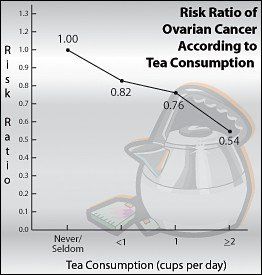Whether you accept it, avoid it or live somewhere in between, insurance coverage has become a defining issue for our profession. Patients increasingly expect to use their benefits, practitioners want to be compensated fairly for their time and expertise, and the system itself remains – at best – fragmented. The encouraging news is that coverage has expanded in meaningful ways. The challenging news is that reimbursement, across the board, remains inadequate.
Green, Black Tea Linked to Lower Risk of Ovarian Cancer
Tea is among the most widely consumed beverages in the world. While hundreds of varieties exist, nearly all teas are derived from three main categories (black, green and oolong). Black teas are made from fully fermented tea leaves; after being crushed and rolled, the leaves are oven-fired, creating a distinctive flavor and color. Green teas are derived from the same leaves as black tea, but the process used to make green tea differs significantly. In making green tea, the leaves are unfermented; they are steamed before being rolled, then dried using a variety of techniques that maximize the tea's flavor. Oolong teas, meanwhile, come from partially fermented leaves, which are steamed after a short time to halt the fermentation process. Depending on when the process is stopped, an oolong tea can more closely resemble green tea or black tea in both flavor and aroma.
In the past decade, a wealth of published research has shown that black and green teas contain substantial quantities of polyphenols, chemicals that block the growth of cancer cells in both laboratory and animal trials. Despite such evidence, the protective role tea consumption plays against the development of cancer in humans remains unclear; even less is known about the ability of tea-based polyphenols to inhibit the growth of specific types of cancer.

A recent study published in the Archives of Internal Medicine has shed new light on the relationship between tea and cancer, and suggests regular consumption of tea can significantly reduce the incidence of ovarian cancer in middle-aged women. The study also indicates a dose-response relationship exists between consumption of tea and ovarian cancer risk, with the risk of cancer decreasing as the amount of tea drunk per day increases.
To investigate this relationship, researchers at the Karolinska Institutet in Stockholm, Sweden examined the health records of more than 61,000 women who had participated in a mammography screening program. All of the women enrolled in the program between 1987 and 1990. Upon enrollment, they completed a food frequency questionnaire, which compiled information on diet, weight, education and other factors. With regard to tea, the women were asked to document their drinking habits over the previous six months, with consumption ranging from "never/seldom" to "four or more times a day."
An expanded follow-up questionnaire was sent to participants in 1997. Incidence of ovarian cancer was tracked from the start of the study through December 2004 using data from national and regional cancer registries.
At baseline, 68 percent of the women reported drinking tea - "mainly black tea," according to the researchers - at least once per month; mean tea consumption among drinkers was 0.8 cups per day. Women who consumed tea were "generally younger and leaner" than non-tea drinkers, and tended to eat more fruits and vegetables.
During the follow-up period, 301 women were diagnosed with ovarian cancer. When the health records of those women were compared to the rest of the study population, "an inverse association between tea consumption and risk of ovarian cancer" was observed.
Compared to women who never or rarely drank tea, women who drank two or more cups of tea per day were 46 percent less likely to develop ovarian cancer. According to the authors, these results remained unchanged even "after further adjustment for age at menarche, age at first birth, age at menopause, family history of breast cancer, and use of postmenopausal hormones." Women who drank one cup of tea daily reduced their risk of ovarian cancer by 24 percent; women who drank less than a cup each day had an 18 percent lower risk.

Further analysis of the data demonstrated "a dose-response relationship between tea consumption and incidence of ovarian cancer." Each additional cup of tea consumed per day appeared to reduce the overall risk of ovarian cancer by 18 percent. The risks for serous and nonserious types of ovarian cancer, meanwhile, were reduced by 15 percent and 28 percent, respectively.
Because the study was observational, the scientists could not conclude that tea alone was responsible for the significant reduction in ovarian cancer risk. For instance, the authors noted that women who drank high amounts of tea "seemed to be more health conscious in their behaviors" than never or seldom tea drinkers; as a result, the reduced risk might have been linked to an overall healthier lifestyle among frequent tea drinkers. However, they noted that the study population was quite large, and the methods used to document tea consumption were of high validity, lending their design significant credibility. They also stressed the finding that the risk of cancer declined steadily as tea consumption increased, which "makes chance less likely."
"In summary," the authors wrote, "our results from a large population-based cohort of Swedish women suggest that tea consumption may lower the risk of ovarian cancer. Because prospective data on this relationship are scarce, our findings need confirmation by future studies."
Ovarian cancer is diagnosed in approximately 20,000 women in the United States each year, according to the National Cancer Institute. It is the fourth-leading cause of cancer-related death among American women, and has the highest mortality rate of all cancers of the female reproductive system.
References
- Larsson SC, Wolk A. Tea consumption and ovarian cancer risk in a population-based cohort. Archives of Internal Medicine, Dec.12/26, 2005;165:2683-2686.
- A Snapshot of Ovarian Cancer. National Cancer Institute, August 2005. Available online at www.cancer.gov/cancertopics/types/ovarian.



